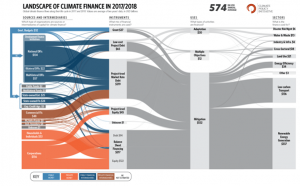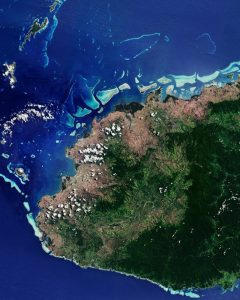Maximising the Impact of Climate Finance with Satellite Data
Marketing

In episode 4 of In-Orbit our host Maggie Aderin-Pocock was joined by Lucy Edge and Christophe Christiaen from the Satellite Applications Catapult, and Einar Bjorgo from UNITAR-UNOSAT, to explore how we can build climate resilience among small island nations, and the role the IPP CommonSensing project plays in this process – Listen here.
Christophe, Sustainable Finance Lead here at the Catapult, discusses the role of satellites and Earth observation in climate finance and what needs to happen to maximise impact for the future.
Climate Finance and the Adaptation Gap
Climate finance refers to finance flows aimed at reducing emissions (mitigation) and increasing the resilience of human and ecological systems to negative climate change impacts (adaptation). As the bulk of international climate finance is channelled towards mitigation solutions, only a fraction is made available for climate change adaptation. This is nowhere near sufficient to address global climate adaptation needs as the effects of climate change are being felt across the world already today.
As part of the Paris Agreement a group of ‘developed’ countries reaffirmed their commitments to mobilize US$ 100 billion in climate finance each year by 2020 for ‘developing’ countries to take climate action. It are those developing countries who have historically emitted least of the greenhouse gas emissions that are driving climate change, who are feeling the impacts of climate change the hardest. It is no surprise then that climate resilience and adaptation is a much higher investment priority for these countries, particularly in small island states like Fiji, Solomon Islands and Vanuatu, who we are working with in the CommonSensing project.
Annual adaptation costs in developing countries alone are currently estimated to be in the range of US$70 billion, with the expectation of reaching US$140–300 billion in 2030 and US$280–500 billion in 2050. Despite an increase in finance available for adaptation, the adaptation finance gap is not closing[1]. Dedicated multilateral climate finance mechanisms, such as the Green Climate Fund, the Adaptation Fund or the Global Environment Facility exist to channel public climate finance from developed to developing countries but have so far significantly underachieved their climate adaptation finance targets. On top of an insufficient amount of adaptation finance being available, the institutional capacity within many developing countries, and small island states in particular, to apply for these funds with their complex and bureaucratic procedures, is often limited.

Source: Climate Policy Initiative – Updated View on the Global Landscape of Climate Finance 2019
Satellite Earth Observation to Maximise Climate Finance Impact
So what can satellite technology do to help address this adaptation gap? When limited financial and human resources for climate adaptation are available, it is important that these are used as efficiently as possible. Satellite earth observation data and any other climate, geospatial or scientific datasets can help developing countries maximise the impact of the available resources through better planning, prioritising and monitoring of climate adaptation interventions:
- Evidence from observed changes in the environment (e.g. coastal erosion, temperature rise) can support the case for climate action from policymakers or within a climate fund application process.
- A full understanding of a region or country’s exposure and vulnerability to climate hazards can help policymakers and investors plan and prioritise interventions and funds for those communities and areas that need it most.
- Satellite data can offer a cost effective and scalable way to monitor the impact of adaptation interventions or changes in climate risk exposure over time.
Data and technology on its own, however, are not enough. It is crucial to build technical and institutional capacity in developing countries so its people can fully use and understand this data to inform their own adaptation plans and agenda. In light of climate justice, it is important that developed countries such as the UK, provide the necessary tools and support, while leaving final climate resilience decisions and ownership with the governments and people in country. CommonSensing has been set up in this spirit to support the people of Fiji, Solomon Islands and Vanuatu, but is only one project. Huge opportunities remain both in the South Pacific and beyond, for our sector to support global climate resilience agenda, driven by those people who have been and are being affected most, while having contributed least to climate change.

Viti Levu, Fiji – Source: https://www.esa.int/ESA_Multimedia/Images/2017/11/Viti_Levu_Fiji
[1] United Nations Environment Programme, 2021; “Adaptation Gap Report 2020”




